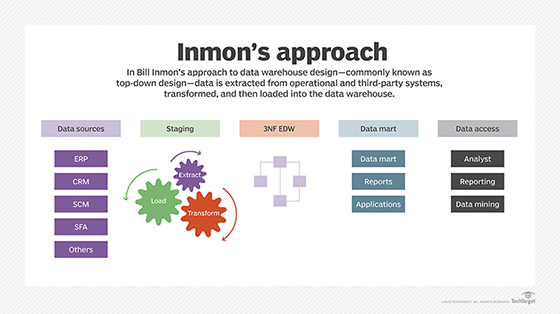Data lake vs. data warehouse: Key differences explained
Data lakes and data warehouses differ in structure, processing and use cases, offering distinct advantages for enterprise analytics and data strategies.
The vast amount of data organizations collect has outgrown what traditional relational databases can handle for BI, analytics and data science applications.
This has created a need for data lakes and data warehouses to manage the data, prompting the question of when to use which and how they compare to each other.
Both data repositories house business data for analysis and reporting, but they differ in their purpose, structure, supported data types, data sources and typical users. Understanding these distinctions clarifies the roles data lakes and data warehouses play in enterprise analytics strategies.
In general, the systems that generate data -- CRM, ERP, HR and financial applications, as well as mobile apps, real-time data streams, network and website logs, sensors and other sources -- feed the two repositories. Organizations process data records from those sources according to business rules and then send them to one of the repositories for ongoing storage and management.
Once organizations load data from disparate business applications, IoT devices and external feeds into a data lake or data warehouse platform, they can identify trends and deliver insights that help organizations make better-informed business decisions. At a high level, a data lake commonly holds varied sets of big data for advanced analytics applications. A data warehouse, on the other hand, stores conventional transaction data for basic BI, analytics and reporting uses.
Let's look more closely at the two data stores and the differences between them.
What is a data lake?
A data lake is usually a vast repository that stores raw data in its native format. One benefit of a data lake is that it can store data of varying structures, not just traditional structured data. Systems tag each stored data element with a unique identifier and metadata to make querying easier when needed. But data lakes don't require a predefined schema at the time of ingestion. Instead, data scientists and other analysts apply a schema to data sets and filter them for specific analytics needs after the ingestion process is complete.
When they first emerged, data lakes were most commonly associated with the Hadoop distributed processing framework. However, as the influx of data continues to grow in organizations, architecture options have increased to include other big data platforms. Many IT vendors also now support data lakes in the cloud, often combining the Spark processing engine and cloud object storage services.

What is a data warehouse?
A data warehouse is a repository for data that business applications generate or collect and then store for a predetermined analytics purpose. Most data warehouses are built on relational databases and, as a result, apply a predefined schema to data. In addition, organizations typically cleanse, consolidate and organize the data for the intended uses before loading it.
Because data in a data warehouse is already processed, it's relatively easy to do high-level analysis. Business managers and other workers who aren't skilled data or analytics professionals can use self-service BI tools to access and analyze the data on their own. An enterprise data warehouse provides a centralized data repository for an entire organization, while smaller data marts can be set up for individual departments. As with data lakes, organizations are increasingly deploying cloud data warehouses as an alternative to on-premises ones.

Data lake vs. data warehouse: 8 important differences
Organizations typically opt for a data warehouse over a data lake when they have a massive amount of data from operational systems that needs to be readily available for analysis to support day-to-day business processes. Data warehouses often serve as an organization's single source of truth because they store historical business data that the organization has cleansed and categorized.
By comparison, a data lake often stores data from a wider variety of sources. A data lake platform is essentially a collection of various raw data assets that come from an organization's operational systems and other sources, often including both internal and external ones.
The following table details eight differences between data lakes and data warehouses.
| Data lake | Data warehouse | |
| Supported data types | Data lakes can handle a combination of structured, semistructured and unstructured data, which is commonly stored in its native format to make the full sets of raw data available for analysis. | Data warehouses typically store structured data from transaction processing systems and other business applications. In most cases, organizations cleanse and curate the data before loading it in a data warehouse. |
| Analytics uses | Organizations primarily use data lakes for data science applications that involve machine learning, predictive modeling and other advanced analytics techniques. Analytics goals aren't always predefined. | Data warehouses support less-complex BI, ad hoc analysis, reporting and data visualization applications, usually with a predefined purpose for analyzing business operations and tracking KPIs. |
| Users | Data scientists and lower-level data analysts are the primary users of data lakes. Data engineers often support them by building data pipelines and helping to prepare data for analysis as needed. | Business analysts, executives and operational workers use data warehouses through self-service BI tools. Alternatively, BI analysts and developers run queries in data warehouses for business users. |
| Data processing methods | Data lakes support traditional extract, transform and load (ETL) processes, but organizations are more likely to use extract, load and transform (ELT), where they load raw data first and transform it later for specific needs. | Data teams commonly use ETL processes for data integration and preparation in data warehouses. They finalize the data structure before loading data sets to support planned BI and analytics applications. |
| Schema approach | Data teams can define the schema for data sets after they're stored in a data lake, using a schema-on-read approach. | Data teams define schemas in data warehouses before loading data sets, following schema-on-write practices. |
| Data storage | Data is typically stored in platforms other than relational databases, such as the Hadoop Distributed File System, cloud object storage services or NoSQL databases. | Organizations commonly store data in relational databases using conventional disk storage. They can also build data warehouses on columnar databases, similar to disk storage. |
| Costs | Hardware costs can be less expensive because data lakes use lower-cost servers and storage. Data management might cost less, too. But the large size of some data lakes can erase the cost advantages. | In general, the large servers and disk storage systems required for data warehouses make them more expensive to deploy than data lakes. Managing a data warehouse can also be more costly. |
| Business benefits | Data lakes enable data science teams to analyze diverse sets of structured and unstructured data and create analytical models that provide insights for strategic planning and business decision-making. | Organizations use data warehouses as a centralized repository of consolidated and curated data sets to analyze business performance and support operational decisions. |
To remember the difference between a data lake and a data warehouse, picture actual warehouses and lakes: Warehouses store curated goods from specific sources, whereas a lake is fed by rivers, streams and other unfiltered sources of water. The same kind of distinction applies to their data counterparts, in a general sense.
Selecting the right platform based on organizational goals
Deciding on a data lake vs. a data warehouse depends mostly on how organizations plan to use their data.
Because data warehouses contain historical data that organizations have already processed and prepared for analytics, they are well-suited for employees with less technical knowledge. Not only is it feasible for business analysts, executives and users to analyze data with self-service BI and analytics tools, but the design of data warehouses often makes it easy for different teams and departments to access the data stored in them. This is why a well-built data warehouse architecture is key to breaking down data silos across enterprise systems.
A data lake is popular for organizations that ingest vast amounts of data in a constant stream from high-volume sources. Data ingestion is relatively uncomplicated because a data lake can store raw data. But such data is more difficult to navigate and work with than the processed data found in a data warehouse. As a result, data scientists typically use data lakes for advanced analytics applications. The flexibility they offer for building different analytical models from the same data sets also makes data lakes a popular choice for enterprises that have diverse analytics needs.
Ultimately, many organizations deploy both types of platforms to support different kinds of data analysis. There are also some cases where combining a data lake and a data warehouse in a unified environment could be the best option. For example, data from a data warehouse might be fed into a data lake for deeper analysis by data scientists. Going even further, new data lakehouse platforms have emerged that combine the flexible storage and scalability of a data lake with the data management and user-friendly querying capabilities of a data warehouse.
Bridget Botelho is head of content innovation for Informa TechTarget.








